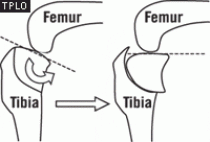Canine ACL tears are debilitating to a dog.
Oftentimes, full tears to a dog’s ACL will require surgical repair to avoid severe, progressive osteoarthritis. Surgical repairs to ACL tears have a high success rate (usually around 95% for all the procedures), but as with all surgical procedures there is always risks involved.
For partial tears, non-surgical treatment may be the better, less invasive option, with surgery as a back-up if the injury does not heal properly.
There are several cruciate surgical techniques used to treat ACL injuries in dogs. However, there is no clear research that points to one technique having better success and outcome than another.
That said, some surgeries are more complicated than others and therefore risks of complications may be higher and the surgery more costly. Some techniques may be better at preventing osteoporisis (arthritis) and others better suited for certain-sized dogs and to individual cases.
Your veterinarian will recommend treatment for your dog based on his/her size and age and the severity of the injury. It is important to discuss with your veterinarian what is the most suitable treatment options with your veterinarian.
Non-Surgical Treatment
Non-surgical, or conservative, treatment may be effective in treating dogs with partial ACL tears.
Conservative treatment can be especially effective in dogs who are less than 30 pounds (13.5).
Conservative treatment includes strict confinement/rest for 6 weeks to 2 months. During this time gentle physical therapy and anti-inflammatory medications (NSAIDs) are prescribed.
Other non-invasive treatments include acupuncture, massage, nutrition, aqua therapy, the use of a leg brace, nonsteroidal anti-inflammatory drugs (such as glucosamine and Perna canaliculus/New Zealand Green Lipped Mussel), weight loss for overweight dogs.
If conservative therapy does not result in improvement, then surgery should be considered.
Surgical Treatments
With surgery, the aim is to repair cranial cruciate ligament ruptures and stabilize the injured joint, returning the joint motion to normal, while reducing the forces that put undue pressure on the knee.
Depending on which surgery is performed the cost can range between $900 to $3500.
ACL surgeries include:
Lateral fabellotibial suture (or lateral suture or the de Angelis suture)
This surgery has been performed for over 30 years and is considered quick, affordable, and safe. The procedure appears to be most effective for smaller dogs (less than 40 lbs/20 kg) as near normal function of the leg is returned. Larger more athletic dogs appear to only have fair outcomes. It also has been observed that this surgery results in thickening and swelling around the joint that may suggest arthritis or more scar tissue.

TPLO cuts the shaft of the tibia
Tibial plateau leveling osteotomies (TPLO)
– This surgery has been around for 10 years. TPLO changes the angle of the knee joint by cutting the bone (an osteotomy) so there is less force acting on the cruciate ligament. A line cut across the shaft of the tibia is made. it is then rotated and held in place with a metal plate and screws.
Dogs who get TPLO surgery are usually back on their feet faster and with less arthritis than with lateral suture. However, as it is a more complicated surgery, there is a higher complication rate. TPLO is recommended for large, athletic dogs.
Tibial tuberosity advancement (TTA) and Triple tibial osteotomy
– TTA changes the relationship of the patellar tendon and tibial plateau angle via an osteotomy (bone cut). Both of these procedures attempt to stabilize knee joint by using existing tendons as well as cuts in the tibia. They are like variations of the TPLO procedure.

TTA cuts the tibia to create an angle to stabilize the knee
Veterinary surgeons recommend these procedures for large dogs as well. Dogs who get TTA usually begin using the leg more quickly than patients having a TPLO procedure, because with the TTA procedure, the tibia is cut only in a non-weight bearing area. The femur sits on top of the uncut portion of the tibia, not through a line cut across the shaft of the tibia, as in the TPLO procedure.
Overall, newer surgical techniques are better at addressing the progression of osteoarthritis and appear to have a higher success rate in larger dogs than lateral suture.
Rehabilitation after Surgery
Care of the incision:
During the first 2 weeks after surgery, special attention needs to be paid to the surgical incision. Your vet should outline what to look for and how to care for the wound.
Swelling around the incision should go down over a 2-week period. Your veterinarian will remove the sutures usually 14 days following surgery.
- Ice compress therapy around the surgical site for 24 to 36 hours immediately following surgery may help with reducing swelling and discomfort. Then warm compress and cold compress should be alternated. Consult with your vet as to the best routine for applying cold and heat.
- Avoid getting the bandaging wet or dirty. Your dog should not be bathed or allowed to swim until the skin sutures are removed. Consult with your vet how best to clean your dog during recovery time.
- The incision should appear clean and dry. Watch for any opening of the incision, excessive swelling, foul smell, or cloudy or smelly discharge from the site as this may indicate infection.
- Licking at the skin incision can encourage infection. If your dog wants to lick or chew at the surgical site an Elizabethan collar (“cone of shame”) may needed until the sutures are removed.
- Do not touch the wound with your fingers as you could infect it. Consult with your vet as to how best to keep the wound clean.
- To minimize swelling, the incision can be cold packed for a day upon returning home. The incision should then be hot packed 3 to 4 times daily for 5 more days.
Limit Activity:
After surgery a dog will need to stay off the injured leg for several weeks (usually between 8 to 12 weeks).
If excessive activity is allowed too soon after surgery, stabilization of the knee can be lost and a dog may require additional surgery. Damage can cause problems with the incision, deep tissue, cut bone, implants and create scar tissue.
It is therefore critical your dog rest and stay off his/her leg while it heals.
- During rehabilitation it’s best if your dog is confined to a small room, playpen, cage or small run to limit activity, especially if left unsupervised.
- Do not let your dog go up and down stairs or jump onto furniture of beds.
- For the entire period of recovery, your dog should avoid slippery surfaces such as hardwood floors and slippery concrete or tile. If this is impossible, get your dog grip booties or socks that will give him/her grip on the flooring.
- When you are not around to observe your dog’s movements, then it is safest to crate your dog or put him/her in a pen/kennel.
- Dogs should be on a hand-held leash (a short leash eg. less than 6 feet) at all times when outside for the first 2 months following surgery so that you can control him/her.
After the initial 48 hours, a routine of light physical therapy should begin.
Physical Therapy Regimen.
Physical therapy is a critical part of the process towards healing ACL injuries. By making time to take your dog to a registered physical therapist, and adhering to your vet’s prescribed physical therapy plan, you will give your dog the best chance of healing properly and returning to normal activity.
Keeping to a daily regimen may be difficult to achieve with life’s hectic schedule. Therefore, it is better to do less than do more when it comes to physical therapy. It will not do your dog any good to rush therapy and try to push the healing with aggressive or infrequent therapy.
However, physical therapy should not be ignored if you wish your dog to get back to normal activity and regain normal range of motion in his/her knee joint. Always consult with professionals when undertaking a physical therapy regimine for treating ACL injuries.
Therapy will include:
- Gentle flexion and extension (bending and straightening) of your pets knee for 5-10 minute sessions three times daily. These are sometimes referred to as passive range of motion (ROM) exercises.
- Warm compresses will be recommended as well to encourage blood flow and healing.
- Muscle massage
- Aqua Therapy
Once healed, dogs can go back to doing virtually any activity, including running, jumping, playing with other dogs and playing ball.
Read more in Part I: Symptoms and Diagnosis
Disclosure: This post may include affiliate links.
